Weekly Email – Advent 1
Documents
Dear friends,
Last week, our bi-monthly online Zoom Theology seminar took place. It was a fascinating evening of discussion all about the rather intriguing question of what difference it would make to our account of the Gospel to discover we are not the only life forms in our universe.
I was particularly pleased that the seminar was led by Fr Steve Rice, a good friend of our parish, from Winston-Salem in North Carolina. It was excellent to be joined by parishioners and colleagues of his, as well as people from the parish of St Mary the Virgin, Times Square, New York City. The potential offered by Zoom for teaching and learning, as well as for sustaining friendships between parishes, is extensive and I suspect we have only begun to scratch the surface of its potential.
At the heart of our discussion was not the sensationalist UFO conspiracy theories one sometimes reads about, but rather a broader question to do with the salvific power of Christ’s death and Resurrection.
Just what do we mean when we say the Paschal Mystery has universal power? Did Christ die just to save us human beings on earth, or is there some sense in which his saving power is so great that it theoretically could encompass things and realms we maybe don’t even know exist?
Fr Steve’s presentation was very interesting indeed. We discovered that this question has been discussed in all eras of the Church’s life. Origen particularly considers the idea of whether other universes and worlds exist in the Patristic period, for example. A key question for early debate revolves around Athanasius’ assertion that only that which is assumed by the Son of God is healed. In other words, can Christ taking human flesh be saving for other life forms in other galaxies and universes? Or does the Incarnation reveal to us the unique character of human life on earth, created in God’s image, and found nowhere else?
By the time of medieval scholasticism, many Dominicans were open to the idea of there being other worlds, whilst Franciscans scholars were usually against it. S. Thomas Aquinas himself, however, opposed the idea on the grounds that perfection is found in unity – only one ordered world was needed to be God’s perfect creation rather than a plurality of competing worlds.
Fr Steve illuminated a very public debate in the 19th Century which I had never heard about, between two theologian-scientists called William Whewell and Sir David Brewster. Whewell was Master of Trinity College, Cambridge, and an Anglican priest. He began by arguing in favour of the existence of several universes, but changed this mind as a result of christological reflection. He couldn’t conceive that there could be more than one saviour, and so there couldn’t be more than one world.
He was pitted in a very public debate against Brewster, a Scottish Free Presbyterian, who argued there must be life elsewhere in the universe and that such an assertion is perfectly possible in the light of the Gospel. Brewster couldn’t see the point of a lovingly created universe if its vast expanses were empty of life and void, apart from the earth.
It is fascinating to discover that this debate even made it at one point into the Barchester Towers novels as a frequently discussed matter among clergy. Fr Jeremy Haselock pointed out that the popularity of this now largely forgotten public discussion in the 1850s would explain the kind of lines that Fr Faber puts in his hymn There’s a wideness in God’s mercy, when he writes in 1854, “There is grace enough for thousands, Of new worlds as great as this; there is room for fresh creations, In that upper home of bliss.” Faber argues that in theory there is no limit on the extent of God’s love and the potential it can achieve.
In many ways discussion of these ideas is a proxy for a number of other questions that lie at the heart of how we understand our salvation in Christ.
A paradox at the heart of the gospel requires us to assert at one and the same time that there is something universal, encompassing all times and places, about the power of Christ’s saving action – so universal that it could in theory stretch even to things unknown as yet to the mind of man.
Yet at the same time, the gospel also calls us to proclaim the particularity of the Incarnation – that it is rooted in the life of a particular person – Jesus Christ. His life is offered up for the salvation of each individual human being, and it is the Incarnation that reveals to us what it means to be human, uniquely created in God’s image, and entrusted with the earth God has made for us.
It strikes me these are the themes that Advent calls us to ponder as we prepare for Christmas – both the particularly of Christ’s birth in Bethlehem, and universality of his future coming at the End of Time, when he will gather all things together in himself. I wish you a holy and blessed Advent, as we enter that season this Sunday and open our hearts to the one who is both the babe of Bethlehem and the universal monarch of all things and judge of all men.
Fr Peter
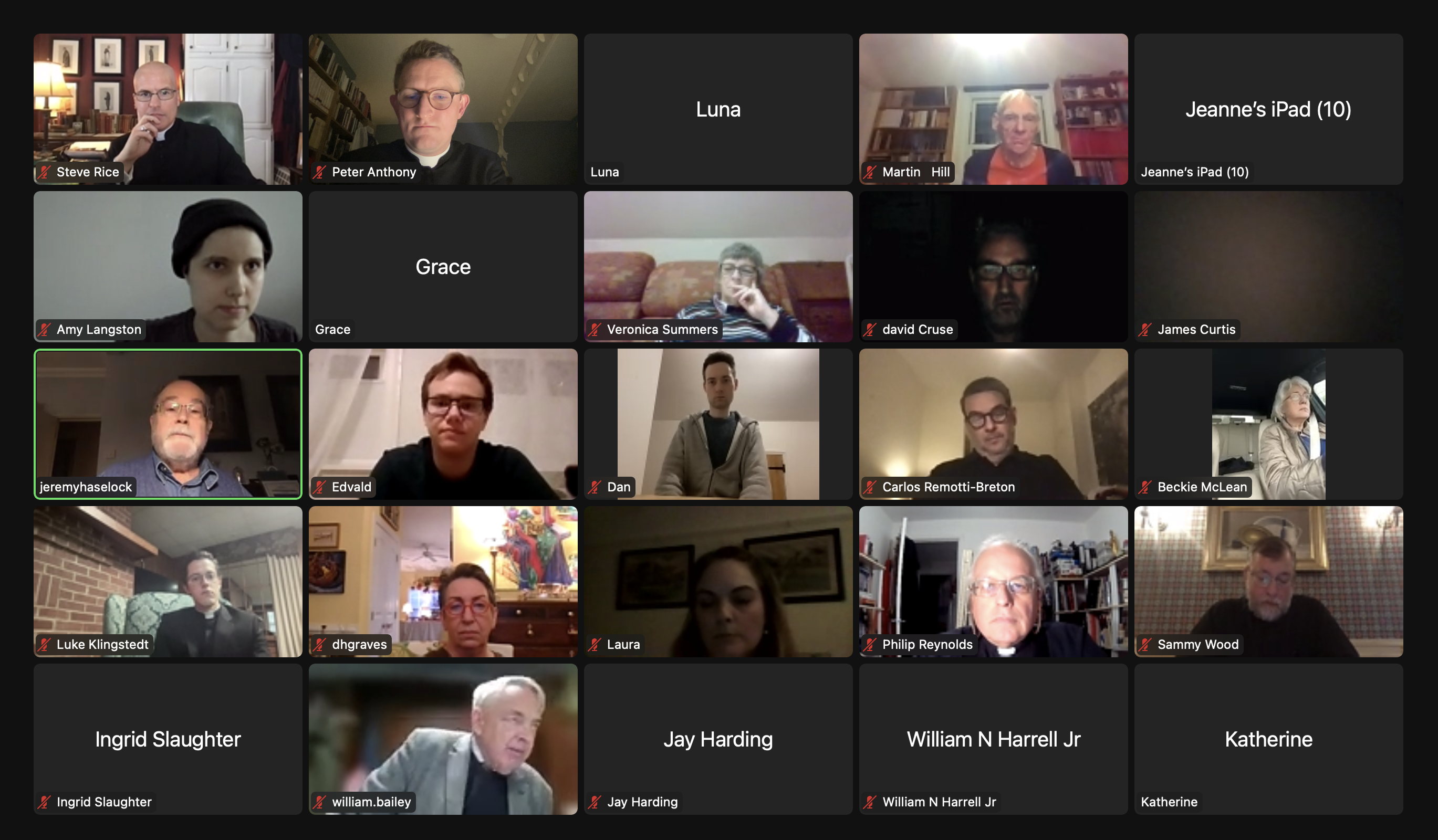
- We were so pleased to be joined by friends from several continents on Tuesday 15th November for our Zoom Theology Seminar. It was a particular joy that Fr Steve Rice led the discussion, and that we were joined by parishioners of his from St Timothy’s Winston-Salem, and also by the Interim Rector of St Mary the Virgin Times Square, New York. We were also very pleased indeed to see Edvald Johnsen, tuning in from Norway! Details of our next Zoom Theology Seminar can be found here.
Advent Carol Service
Join us this Sunday at 6.00 pm for our annual Advent Carol Service. It is one of the most beautiful services of the year and a wonderful way to immerse yourself in the music and spirit of Advent as we await the birth of the Christ Child.
There will be an opportunity to sing some of the great Advent hymns, such as: Lo he comes with clouds descending; Hills of the North; O come, O come Emmanuel; A Great and Mighty Wonder; and Come Thou Redeemer of the Earth.
The wonderful music provided by our choir will include: Fleming, Kindle a light; Goldschmidt, A Tender Shoot; Byrd, Rorate caeli; Macmillan, O radiant dawn; Grieg, Ave Maris Stella; and Ramsey, O Sapientia.
The liturgy finishes with Benediction as we bring our prayer and praises to him who comes to us in glory at the end of time, in the Babe of Bethlehem, and in the Most Holy Sacrament of the Altar.

In the sermon at the Solemn Mass last Sunday, Fr Julian pondered the mystery of the Kingship of Christ: “I think until the modern era, Christians were less interested in puzzling over the truth about God, than in participating in it; not mastering the truth, controlling it, but being mastered by the truth.” To hear more, you can listen again here, and read the text of the sermon here.
Walsingham Silent Retreat
Friday 2nd December-Sunday 4th December 2022
There are still places available for our silent retreat in Walsingham from Friday 2nd – Sunday 4th December. The cost is £182 (including full board plus mini-coach from Kings Lynn – retreatants need to book their own train ticket to Kings Lynn, arriving in time for our mini bus which will pick us up at 3.30 pm).
The retreat leader is Rt Revd Roger Jupp, Vicar of St Lawrence, Long Eaton. This retreat will be silent from after supper on Friday night to the Parish Mass on Sunday morning. Please be in touch with the parish office to book a place.
Immaculate Conception
Please note that the feast of the Immaculate Conception of the Blessed Virgin Mary will be celebrated on Thursday 8th December Thursday 8th December 2002, with a High Mass at 6.30pm. Music: Rachmaninoff-Vale, Mass in B-flat; Motet: Bruckner, Ave Maria. Preacher: the Vicar.
Next Zoom Theology Seminar
Our next Zoom Theology seminar will take place on Tuesday 24th January 2023. Its subject will be: “When history is painful: difficult and contentious memorialisation in churches.”
This seminar will be led by Fr Charles Card-Reynolds, and will take the example of S. George’s Cathedral, Kingstown, St Vincent which contains multiple colonial era memorials to those directly and indirectly involved with enslavement.
How might we respond to the challenge of these memorials and those like them in Britain and her former colonies?
Our speaker, Revd Canon Charles Card-Reynolds MA (Cantab), BD (Londin), Vicar of St Bartholomew’s, Stamford Hill, has been the Bishop’s Commissary for the Diocese of the Windward Islands since 2012.
The Zoom link for the seminar can be found here.
King Charles the Martyr
The annual commemoration of the saintly death of King Charles I, which is organised each year by the Society of King Charles the Martyr, will take place at All Saints’, Margaret Street, on Monday 30th January 2023 at 12 noon. This is because the Banqueting House is still undergoing renovation.
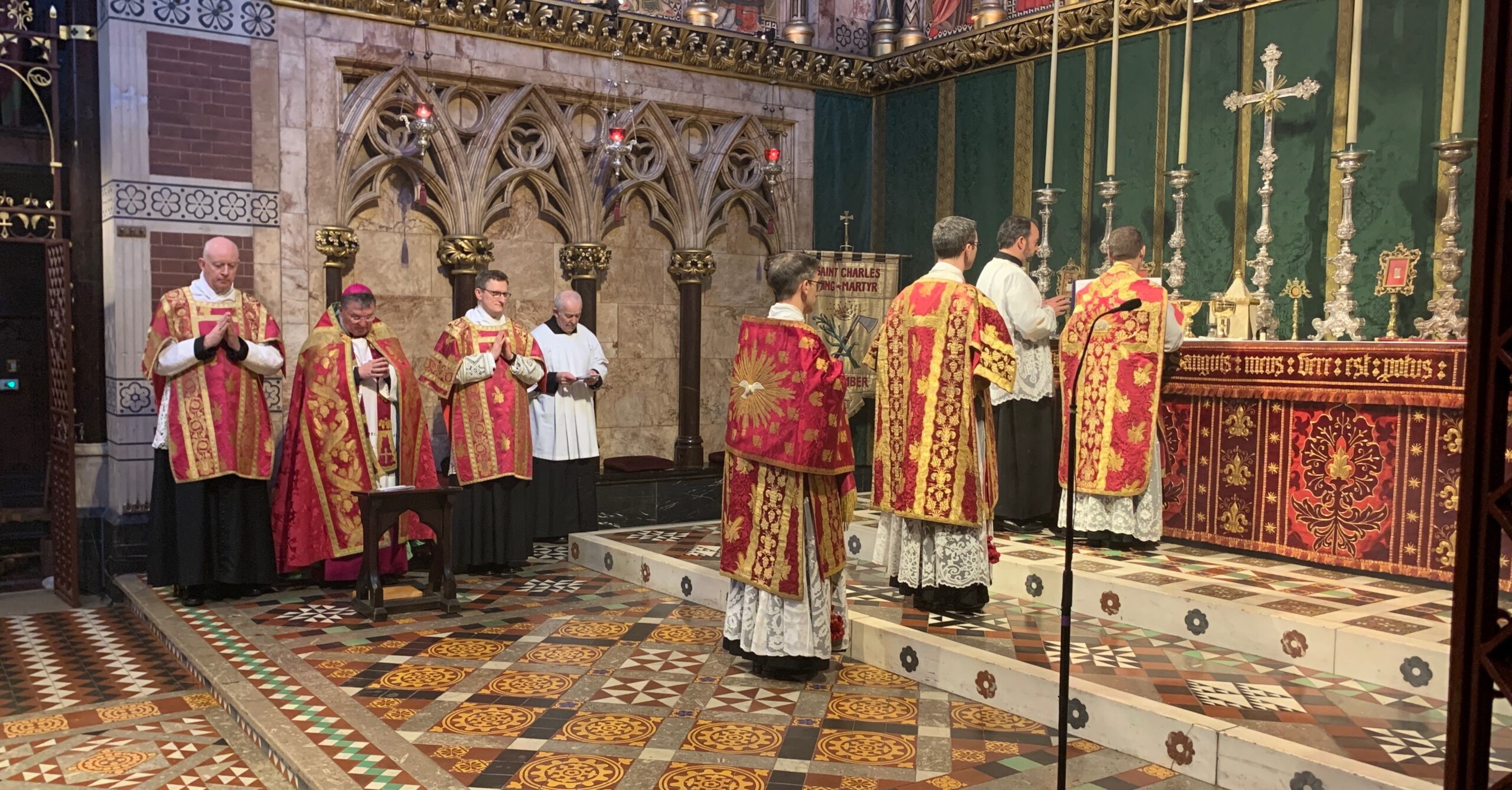
Were were pleased to host the annual commemoration of the Society of King Charles the Martyr last year, whilst the Banqueting House was out of action due to renovation. A very large number of people attended the liturgy and there was exceptionally high take-up of the livestream, which we were able to offer. We look forward to welcoming the Society of King Charles the Martyr again in the new year.
Adoremus Pilgrimage at Walsingham
Huw Pryce, one of our churchwardens, reports on his experience of the Adoremus Pilgrimage in Walsingham last weekend:
Last weekend I attended Adoremus, a Walsingham pilgrimage for those aged 18-35. Over three days there was teaching, services in the Shrine and fellowship, all interspersed with the excellent meals in the refectory.
Teaching covered the Holy Family through the Sacred Heart of Jesus, the Immaculate Heart of Mary and the Chaste Heart of Jesus. Contrary to possible expectations, the pilgrims varied from those who have grown up surrounded by Anglo-Catholicism to those new in the faith, only recently baptised or confirmed. So as well as the history of these devotions and reflections on the biblical mentions of the Holy Family, there was also an introduction to the rosary and plenty of opportunities for those from different backgrounds to share their perspectives.
There were trips to the Bull pub in the village, as well as a trip out to Hunstanton for those who wanted to see the sea. It was a lovely opportunity to spend time with each other and balance the many services in the Shrine with some sunshine. Everybody I spoke to agreed the pacing and mixture of the pilgrimage was perfect: all the different elements combining to ensure a relaxing but spiritually rewarding weekend.
Being at the very end of the pilgrimage season the schedule of services was slightly different to account for the earlier sunset, but still had all the elements familiar to all pilgrim groups: visits to the Holy House, Mass in the Shrine and St Mary’s along with services of healing and thanksgiving. While never feeling overly packed or rushed, it was a full programme, and thanks to it being Christ the King on Sunday we had benediction three times within two days.
I left having caught up with friends from prior visits as well as making new ones. I felt refreshed spiritually and looking forward to when I will next be able to make it to England’s Nazareth. Most of all, it was encouraging to see so many younger adults attracted to Walsingham and our tradition. I hope this shows that we have much to offer which is attractive to those who might never have heard of Walsingham, All Saints’ or Anglo-Catholicism.
Huw Pryce
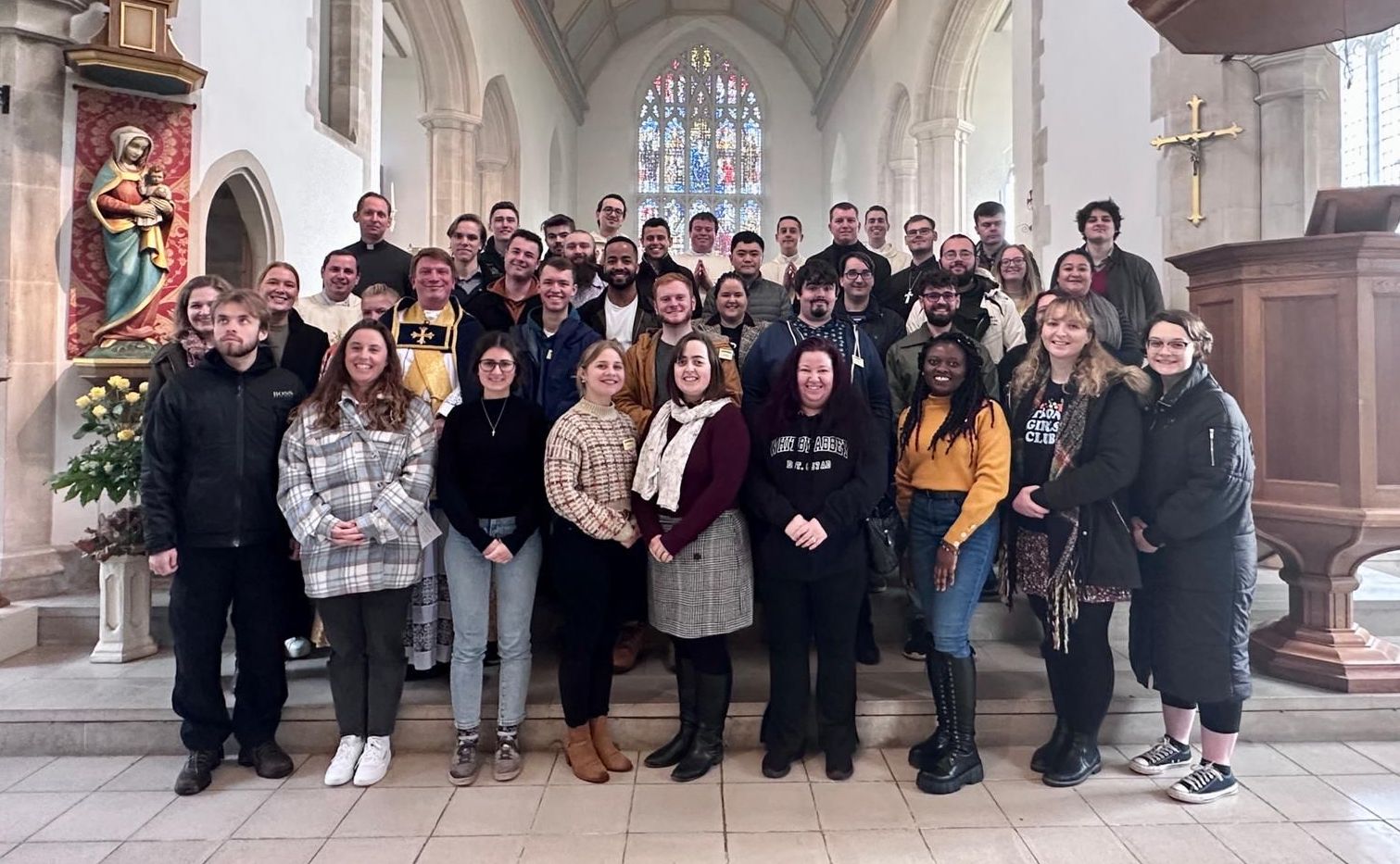
The participants on the Adoremus Pilgrimage at Walsingham last weekend. Huw is in the middle row, three or so people in from the right.
The treasures of Bruges
Fr Peter reflects on the extraordinary shrine of the Precious Blood to be found in Bruges:
During a period of holiday in Belgium over the past week I have been able to fulfil a wish I have had for many years – namely to visit the famous Shrine of the Precious Blood in Bruges.
The prized object at the heart of the shrine is a small file of human blood, said to be Christ’s, collected by Joseph of Arimathea when we was washing Jesus’ body in preparation for burial.
The Basilica containing this relic dates from the 12th century and is very unusual. There is a lower church dedicated to St Basil, but the shrine of the Precious Blood itself is built over that church producing a curious double-decker church with two levels.
You enter the shrine of the Precious Blood through a magnificent late medieval staircase. The upper church, originally in romanesque style was destroyed by the French during the wars after the French Revolution, and so is largely a nineteenth century neo-gothic reconstruction. The sense of centuries of prayer and of God’s presence in the place is extraordinary – it is definitely a place of holy encounter with the living God. Dozens of candles left by pilgrims burn in the beautiful gloom as people make their way to reverence the file of blood.
The file itself is exposed in a side chapel on a special platform which one ascends in order to reverence the relic. The file is chained to the neck of a priest guarding it at all times so it cannot be stolen! I was able to spend a few wonderful moments in silent contemplation in its presence, thanking the Lord for the sacrifice of Calvary (one is no longer allowed to kiss is because of COVID).
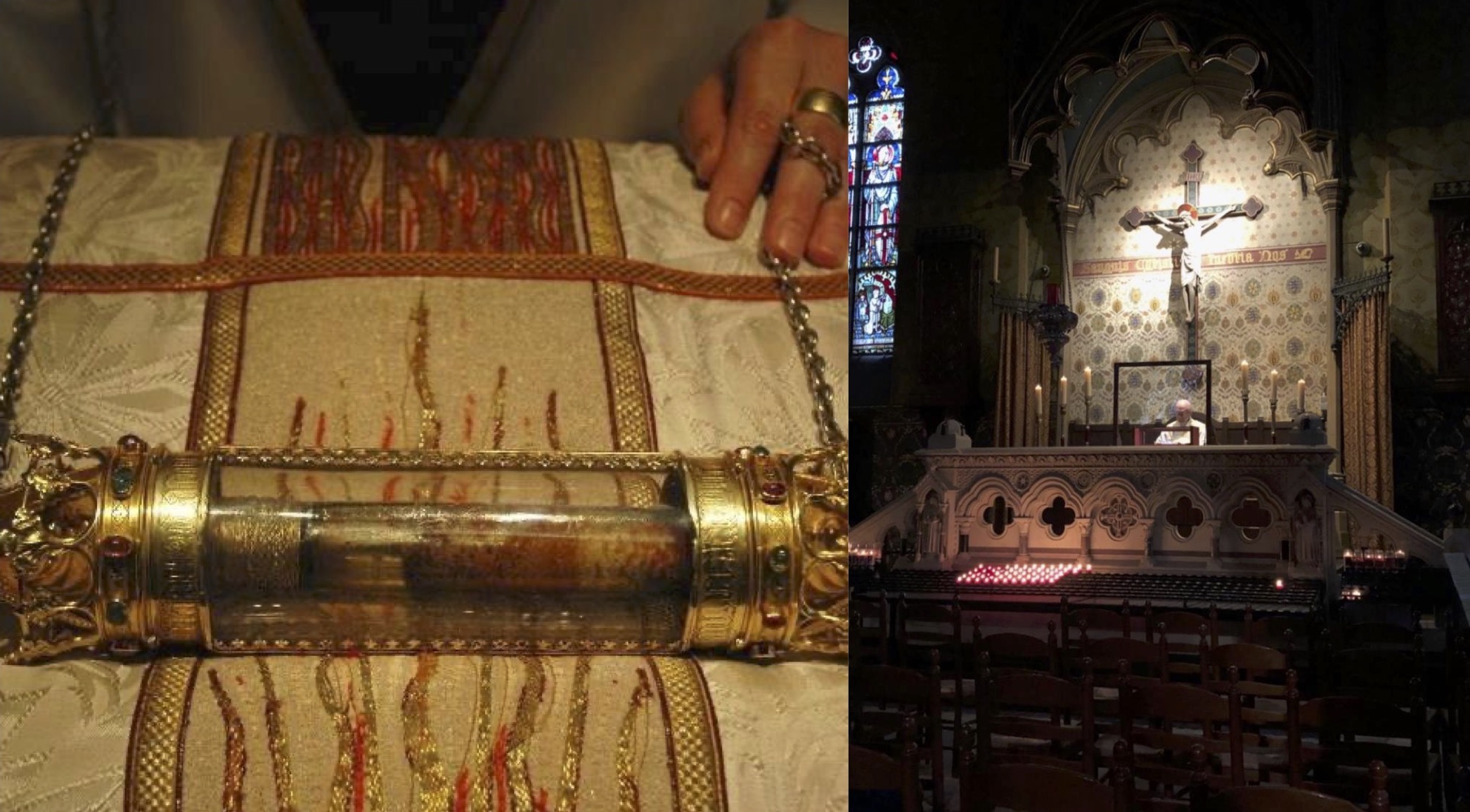
[Left: the file of the Precious Blood close up. Right: the “viewing platform” you have to ascend in order to reverence the relic, which is kept chained to a priest’s neck at all times!]
How the relic got to Bruges, nobody really knows. It is supposed to have been brought back from Jerusalem during the Second Crusade in 1150 by Thierry of Alsace. However, very little evidence can be found to prove its presence in Bruges much earlier than 1256. Indeed a list of famous relics dating from the mid 12th century (to be found in the British Library) records the relic of the Precious Blood still being in Constantinople.
However and whenever the relic arrived in Bruges from the Holy Land, it has been treasured by the people of that city over many centuries and has had to be hidden on several occasions to preserve it from danger.
During the Reformation, the shrine became the focus of Protestant rage. This beautiful focus of prayer and devotion was cruelly destroyed, the church stripped and ravaged, and any precious metals melted down. Mercifully, the relic itself was spirited away and was secretly plastered into a wall so the iconoclasts couldn’t find it. Once the city was liberated from Calvinist tyranny by Spanish forces in 1584, the shrine was rebuilt and the file of blood restored to its place of honour.
The relic of the Precious Blood was hidden a second time during the persecution of the Christian faith which took place in the wake of the French Revolution. This took place under the guise of an ingenious fake heist organised by a group of priests to make it look like the relic had been stolen! It remained hidden in one of their houses until 1819 when it could be restored to public veneration.
The Precious Blood was also spirited away by brave priests in both World Wars during the German occupation suffered by Bruges. It was hidden in the Episcopal Palace so as not to fall into Nazi hands.
Each year, the relic is publicly venerated in a beautiful procession through the town on Ascension Day. The extraordinary reliquary in which the file of blood is carried is a stunning example of 17th century Flemish craftsmanship. The black diamond in the centre of the shrine used to belong to Mary Tudor.

[Left: The relic of the Precious Blood in procession through the streets of Bruges. Right: the 17th Century shrine close up, with Mary Tudor’s black diamond in the centre of the front of the reliquary.]
However this remarkable file of blood made its way to Bruges originally, we may be sure that it has been the focus of an extraordinary outpouring of prayer and thanksgiving over the centuries. It has played an astonishing role in the way the Catholic faith has been preserved in that city through terrible periods of war, crisis, and destruction, and has prompted the building of one of the most intriguing churches in Flanders.
Well might we join with the writer of the hymn, in saying, ” Lift we, then, our voices, swell the mighty flood; louder still and louder praise the precious blood!
Fr Peter
Archbishop Angelos’s Address
His Eminence Archbishop Angelos, Coptic Archbishop of London, gave a wonderful address to the Bishop of Fulham’s Lay Congress last Saturday. It was a great honour to have a gust of such ecumenical significance at the study day.
The topic of the congress was focussed on the vocation of the baptized to share in Christ’s prophetic, priestly and kingly character. Archbishop Angelos’s address is really worth listening to if you were unable to attend. You can find videos of all the day’s presentations on the Bishop of Fulham’s Facebook page here.
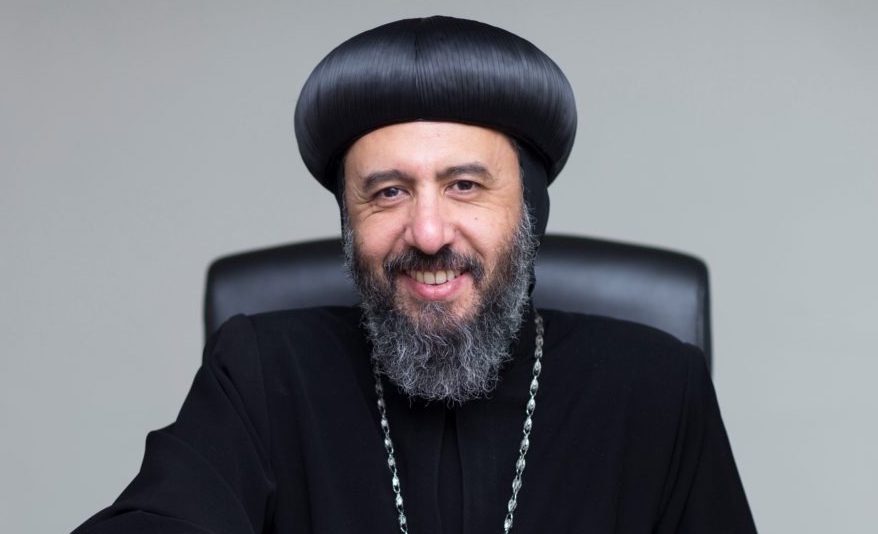
His Eminence Archbishop Angelos, who addressed the Bishop of Fulham’s Lay Congress at St Andrew’s, Holborn, last Saturday.
Flowers this week
The flowers are given by Stephen Miller in memory of his dear Mother, Lovinia.
We are looking for volunteers to help with the flowers in church and the Courtyard Garden. If you have a particular talent for flower arranging or gardening, or can even help with watering or sweeping the courtyard, please contact Shawn on 07988 287 663 or shawnwilbe@outlook.com. If you would like to make a donation for flowers or the garden, please contact Shawn.
Links for Sunday
The links for the livestream and service sheet for this Sunday’s High Mass are at the end of this email.
The service sheet for Sunday’s Advent Carol Service is also attached. The service will be livestreamed here.
Prayer list
The sick
Fr. Harry Hodgetts, Elizabeth Lyon, James Shrimpton, Gloria Fleming, David Craig, Martin Berka, James Rodger, Amanda Barrett, Don McWhinney, Benedict Milne
The faithful departed
Jason Dowler
Anniversaries of death
November 27th – Edith Martin, Margaret Mack, Charles Hawksley, James Crompton, Joseph Kirkham, Margaret Pickering, Valerie Oram, Ann Cook, Phyllis James, Valerie Reddington
28th – Annie Marshall, Doris Harmsworth, Lovinia Miller
29th – John Clough
30th – Walter Ward, Archibald Ward Pr., Emily West, Katherine O’Neil, Chris Gudgeon
December 1st – Sarah Eynstone Pr., James Mason
2nd – David Prior
3rd – Margaret Rodger, Douglas Lawson, Kenneth Armstrong
The Friends of All Saints’
November 27th – Charles Thomson, James Thomson, Jeremy Thorp, Daniel Turner, Christine Vaughn Lillie, Sam Walsh
28th – Christopher Walsh, Christopher Waterhouse, Philip Wayne, Fr. Benjamin Weitzmann, Michael Westcott
29th – James White, Matthew Whittaker, Tim Widdowfield, David Wilcox, Ian Wilson
30th – Juliet Windham, Philip Wood, Martin Woods, Martin Wooley, David Wright, Fr. John Wylam
December 1st – Mark Allan, Martin Amherst-Lock, Bryan Anderson, Mary Attenborough, Richard Ayling, James Babington Smith
2nd – Ruth Baker, Stephen Barber, Fr. Roger Beck, Dr. William Benefield, Charlotte Black, Joy Blacklock
3rd – David Blunden, Colin Bodkin, Fr. Michael Bowie, Eric Broglé, Fr. Julian Browning, Mrs. Margaret Burgess
Service times this week
Sunday 27th November – Advent 1
11.00 am High Mass
5.15 pm Low Mass
6.00 pm Advent Carol Service and Benediction
Monday 28th November – Feria
12.00 noon Mass
6.30 pm Mass
Tuesday 29th November – Feria
12.00 noon Mass
6.30 pm Mass
Wednesday 30th November – St. Andrew, Apostle
12.00 noon Mass
6.30 pm Mass
Thursday 1st December – Feria
12.00 noon Mass
6.30 pm Mass
Friday 2nd December – Feria
12.00 noon Mass
Saturday 3rd December – St. Francis Xavier
12.00 noon Mass
6.30 pm Vigil Mass of Sunday
Sunday 4th December – Advent 2
11.00 am Solemn Mass
5.15 pm Low Mass
6.00 pm Evensong and Benediction
